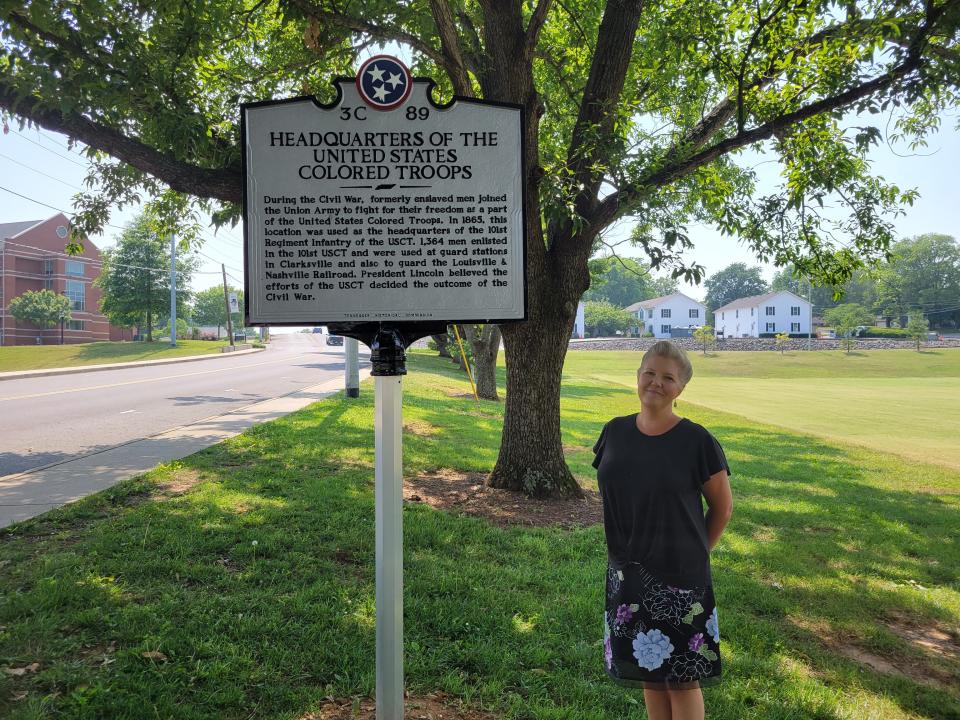'Unforgetting the forgotten': Remembering the 101st United States Colored Troops
Frederick Murphy and Tracy Jepson hope their efforts will shine a light on the ugly side of history that has been buried for so long, with a mission of "unforgetting the forgotten."
Thanks to the efforts of Murphy and Jepson of the Tennessee African American Historical Group, another marker documenting Clarksville's rich history is now displayed in front of the Dunn Center at Austin Peay State University.
The Dunn Center, home to the university's basketball teams, once housed the 101st Regiment Infantry of the United States Colored Troops (USCT) during the Civil War. 1,364 men enlisted in the regiment and guarded stations in Clarksville and along the Louisville & Nashville Railroad from Confederate troops.

The Dunn Center used to be the Howard Pettus Home. It wasn't until Phyllis Smith with the Mount Olive Cemetery Preservation Society went to Washington, D.C. and found a document containing a rough sketch of the Pettus home that the USCT headquarters was discovered. Smith took the document to Montgomery County archivist Jill Hastings who identified the building and its location.
"Of the 101st regiment, almost 300 of them died, most of them from disease.," Jepson said. "They would die at what was called the Clarksville post Hospital, which we don't know where that was or where their bodies are buried."
And yet, at least one is known — USCT soldier Joseph Farley who is buried in Evergreen Cemetery. Farley escaped his plantation and made a run for Fort Defiance in 1865. He served Company D and some of his words were found in the archives:
"They were might hard on colored people. They hung two men by the neck right where I was living. That was way before the Civil War. Back in those days colored people couldn't leave their homes without a pass from their master and mistress...Back there they bought and sold colored people just like they do horses and mules now. Many husbands, wives, and children were separated then and never met again."
Farley goes on to describe an encounter with rebel soldiers:
"I came to Hopkinsville, then to Clarksville...but a pickett halted me. The rebels wore grey. They asked me where I was going and I told them I was going to Clarksville to join the army. At that time I never thought about dying. I never thought about anybody shooting me; I just thought about shooting them."
Lots of former slaves made the trip by foot. Others were liberated and chose to sign up under the direction of USCT soldiers, including other freed slaves who had already made it to the regiment.
"You had to take a chance by leaving your enslaver and crossing what would have been deemed enemy lines at that point," Murphy said.
For Jepson and Murphy, this project is about educating Clarksville about her history.
"When our group started putting up the markers our mission was about unforgetting the forgotten," Jepson said. "There's so much of the story of our historical narrative that many people don't know in our community. There's never been a focus on it. How many students walk past the Dunn Center every day and don't know?"
Murphy added, "There's so much that's going on and has gone on that people don't understand the origins of. Hopefully, that's what our group provide."
The 101st USCT's sacrifice was instrumental to the outcome of the Civil War. Now their history is just as crucial to the city of Clarksville.
Visit the TN African American Historical Group's website to learn more.
This article originally appeared on Clarksville Leaf-Chronicle: 'Unforgetting the forgotten': Remembering the 101st US Colored Troops

